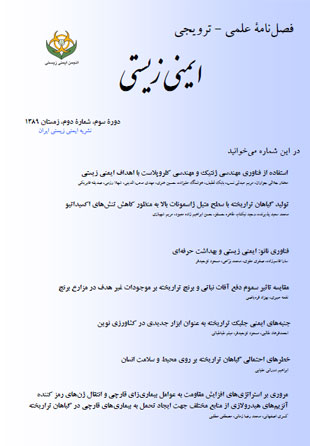فهرست مطالب

فصلنامه ایمنی زیستی
سال سوم شماره 2 (زمستان 1389)
- تاریخ انتشار: 1389/10/20
- تعداد عناوین: 8
-
-
معرفی کتابصفحه 131
-
Page 9Using plants as bioreactors to produce recombinant proteins (Molecular Farming) has different premium benefits compared to other pharmaceutical production systems. Plant expression systems in comparison with other bioreactors have several advantages over the other technologies including their economic advantage, high production, scalability, edibility, possibility of expression of proteins in specific part of plant and organelles in plant cells and being free of protein and pathogen contamination. But, bio-safety concerns should also be addressed when using GM plants. Some of these concerns are: product safety, existing selectable markers resistant to antibiotics in products and, gene flow from GM plants to non transgenic plants, wild types and weeds. In spite of existing different physical and biological methods to limit gene flow, it is one of the most important subjects in the safety of GM products. The plastid DNA itself is lost during the process of pollen maturation and is not transmitted to the next generation and the lack of plastid DNA in pollen thereby minimizes the possibility of leaking transgenes to related weeds or crops. Therefore, this method is one of the best methods in biosafety of transgenic plants. In this article, we will study important aspects of gene flow from GM plants, chloroplast transformation and also we will consider successes in the production of some recombinant proteins in the Faculty of Agriculture at Tarbiat Modares University. A lot of the companies producing transgenic plants have understood the importance of this aspect and have included it into their research and marketing strategies so that it will reduce the anxiety. The selectable genes are the first and the most important candides that should be avoided in producing transgenic plants. In the near future, eliminating selectable marker genes will be one of the most important steps in the production of transgenic plants.Keywords: Molecular farming, Gene escape, Chloroplast transformation, Genetic engineering
-
Genetically Engineering Plants with High Levels of Methyl Jasmonate Could Redcued Oxidative StressesPage 33Oxidative stress arises from an imbalance between the production of reactive oxygen species (ROS) and physiological antioxidant capability. OS play important roles as secondary messengers in many intracellular signaling cascades aimed at cell survival and maintaining the cell in homeostasis with its immediate environment. At higher levels, they can cause indiscriminate damage to biological molecules, leading to loss of function and even celldeath. Methyl jasmonate (MeJA) is a fragrant volatile compound and has proven to be distributed ubiquitously in the plant kingdom. Methyl jasmonate and its free-acid jasmonic acid (JA) – collectively referred to as jasmonates – are important cellular regulators involved in diverse developmental processes and activate plant defense mechanisms. In the past few years exogenous methyl jasmonate treatment has been studied and applied in many cases. Recently several groups have reported that methyl jasmonate treatment reduces oxidative stress in plants and also exhibits anti-pathogenic activity. As the main use of pesticides is their actions on pathogens especially insects, methyl jasmonate could be introduced as an alternative to pesticides. This natural growth regulator activates plant defense mechanisms in response to insects and pathogens without any environmental pollution or hazard for human health. Generation of transgenic plants with high levels of jasmonates could decrease the risks of oxidative stress in plants and will result in benefits in crop yield.Keywords: Methyl Jasmonate, Oxidative stress, Environment, Pesticide, Gene transfer
-
Page 45Nanotechnology promises to advance the human life quality, but it has also aggravated concerns about potential side effects on workers and consumer’s health and the environmental poluution. Risk assessment and management of nanotechnology will be effective when the followings are taken into consideration: 1) Understanding how synthetic nanoparticles (NPs) can gain entry into the human body (routes of exposure); 2) knowing about ways that synthetic NPs can move from the entrance point to other organs in the body (translocation); 3) determining what unfavorable biological effects may occur in presence of synthetic NPs (toxicity); 4) knowing which dose of NPs is safe (exposure and dose metrics); and 5) deciding what is the best way to monitor exposed peoples for health surveillance. This article evaluates currently known potential health risks associated with the use of NPs to workers who are in direct contact to synthetic NPs and highlights the best methods to control those risks, to ensure that their use in the laboratory and industry match with principles of occupational health and biosafety.Keywords: Nanotechnology, Biosafety, Workers health, Human health, Risk assessment
-
Page 63Both legal and illegal rice importation have increased in the past decades in Iran. Annual rice importation during the last decade was always more than one million metric tons. Local rice production cannot compete with the imported rice due to the stability of foreign exchange rate in the last decade in one hand and increased cost of rice production mainly due to double digit inflation and recently the cutoff of the subsidies on the energy and other items on the other hand. Rice production in Iran is also suffering from the insect damage mainly the striped stem borer (Chilo supressalis). Traditionally, rice insect pests are controlled by heavy application of chemical insecticides in the form of 5 to 10 percent Diazinon granule. This in turn is considered as one of the points affecting the price of rice production in addition to its negative impact on the environment including non target organisms and human health. Genetic engineering offers a new and safe solution for this old problem. Iran is the first country in the world to officially release and commercialize an insect resistant rice cultivar Tarom Molaii in the year 2004 coinciding with the international year of rice. Fast adoption of this technology by farmers and public acceptance was remarkable. Insect resistant Bt rice cultivation resulted in significant reduction in chemical insecticide application, increased population of non target organisms, less pesticide residue in the final product, lower cost of production and relatively higher yield. In this article a comparison is made between two decisions: opting biotech rice or continued application of chemical insecticides for controlling insect pests in rice cultivation and the implications of such decision on the environment and non target organisms, taking also into account human health.Keywords: Transgenic rice, Non, target organisms, Chemical pesticides, Biosafety, Genetic engineering
-
Page 77Having considered that genetically modified organisms and their products are increasingly being used in the developing countries, observing biosafety rules and legislations as a tool to guarantee products` safety is recommended. Although biotechnology simulates the same mechanisms as the nature’s, however, some concerns about its potential risks and consequences when used inconsiderately have been raised. Therefore, it is undeniable that like other newtechnologies, biotechnological applications could carry some potential risks too. Having all taken into consideration, it could be concluded that exploiting new opportunities created by genetic engineering approaches is feasible provided that appropriate risk analysis and applying scientific methods for decreasing or preventing the risks involved, are performed. In this paper, the various aspects of bioethics and biosafety of introduction and application of genetically engineered microalgae are discussed. Also, the potential applications of these microorganisms and their bioproducts in social health and hygiene, bioremediation and green fuel production have been reviewed. The unique physiologic abilities turn microalgae as a prominent tool in reaching the goals of biotechnology in line with biosafety aspects.Keywords: microalgae, transformed, GMOs, biosafety, biofuel
-
Page 93Genetic engineering is a powerful tool to overcome the existing restriction in pyramiding good traits in organisms. Steady on increase in area under the cultivating of transgenic plants in last two decades shows that transgenic crops are now as an unseparatable part of modern agriculture. However, despite of good acceptance of this technology, there were some groups that raised concerns about human health and environment. Despite of healthy consumption of Genetically Modified Plants (GMPs) for the last two decades, there are still some concerns about their use as human food. Basically, opponents of GMPs can be divided into three groups; general people, scientist and people with illegitimate objectives. The concerns of the first group of people rose from malinformation shared with them in this subject which can be affected by both of two other group's opinions. The third group requires an ethical discussion which is out of the scope of this paper. So, in this paper focuses will be made on the concerns that have been expressed by scientists. Their main concerns are the harmful effects of GMOs on human health and environment. Although this disagreements as an assumption made the detailed analysis of this plant before release, but fortunately there was no evidence from harmful effects of this crops on human health and environment. On the other hand it must be mentioned that plants improved using classical breeding are not subjecting to this kind of premarketing safety assessments.Keywords: Biosafty, transgenic plants
-
Page 105Fungal diseases are rated as one of the most important factors contributing to yield losses in many crops and different methods use to overcome these phytopathogens. Development of tolerant plants is one of the most efficient approaches against plant diseases which inhibit environment and product pollution because of reducing of chemical fungicides usage. In the past decades, by using modern biotechnology techniques, researchers have been isolated and transformed genes of interest to plants. By this precise and accurate transformation, a desirable gene is selected and inserted directly into plant cells. This technique enables us to gene transfer between species that would not naturally cross and allows breeders to use genes from plants and unrelated organisms such as fungi or bacteria. Some of the defense mechanisms which plants have evolved to respond to pathogens have been identified by studying host-pathogen interaction and responsible genes were isolated and transformed to plants. By the year 2011, no fungus resistant transgenic plant has released to market whereas herbicide tolerance, insect resistance, altered composition and viral resistance (few cases) have been the dominant traits of transgenic plants. In this article, several resistance strategies against fungal diseases and related mechanisms will be addressed. Furthermore the present review will focus on hydrolytic genes responsible of fungal diseases resistance and different sources of them. Transformation of hydrolytic genes from mycoparasitic fungi Trichoderma to potato (Solanum tuberosum L.) and biosafety concerns will be discussed as well.Keywords: Fungal diseases, Hydrolytic enzymes, Chitinase, Glucanase, Transgenic Plants


